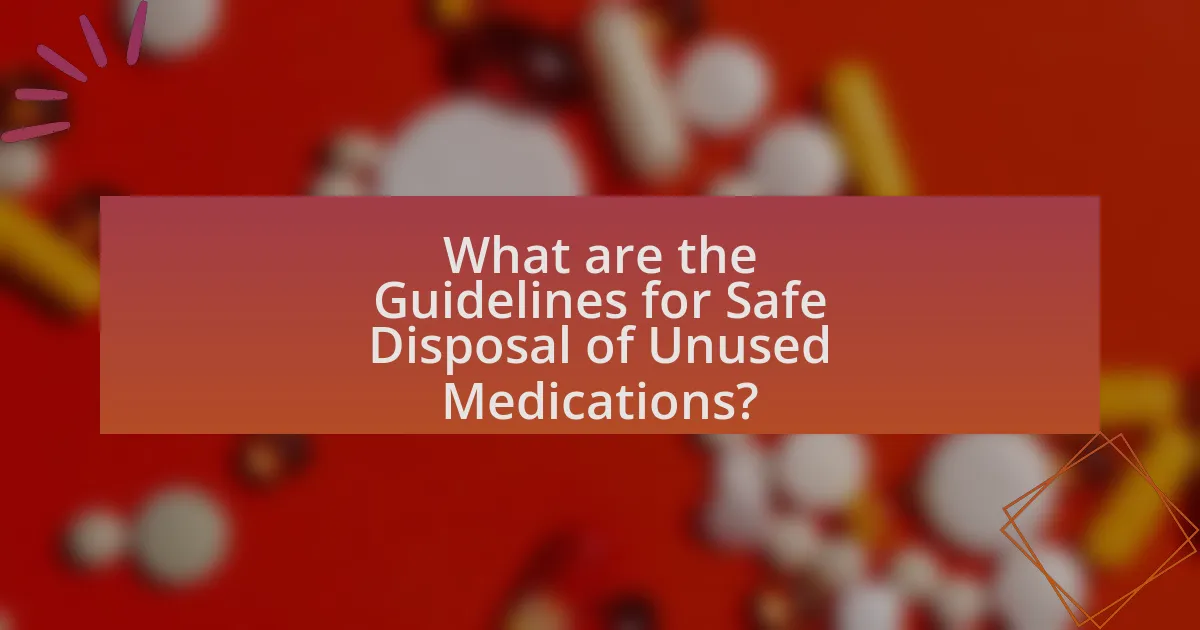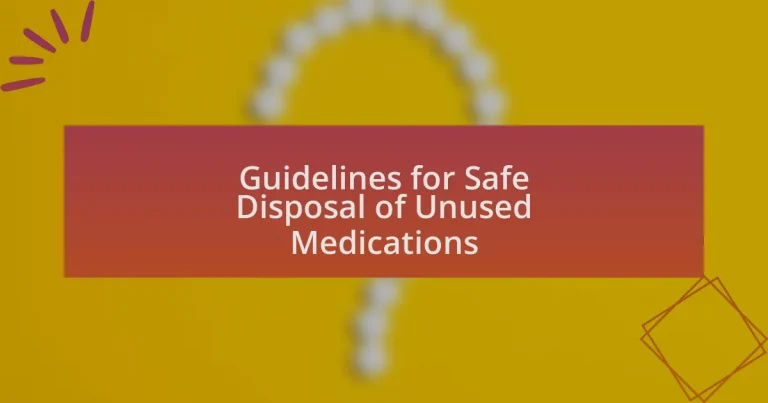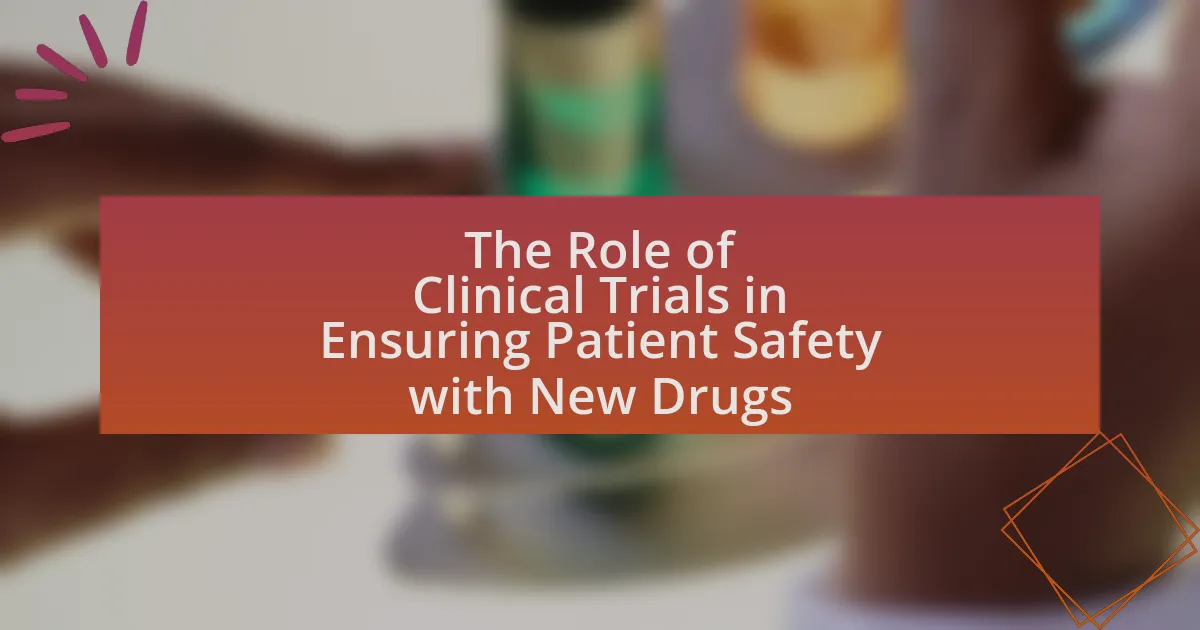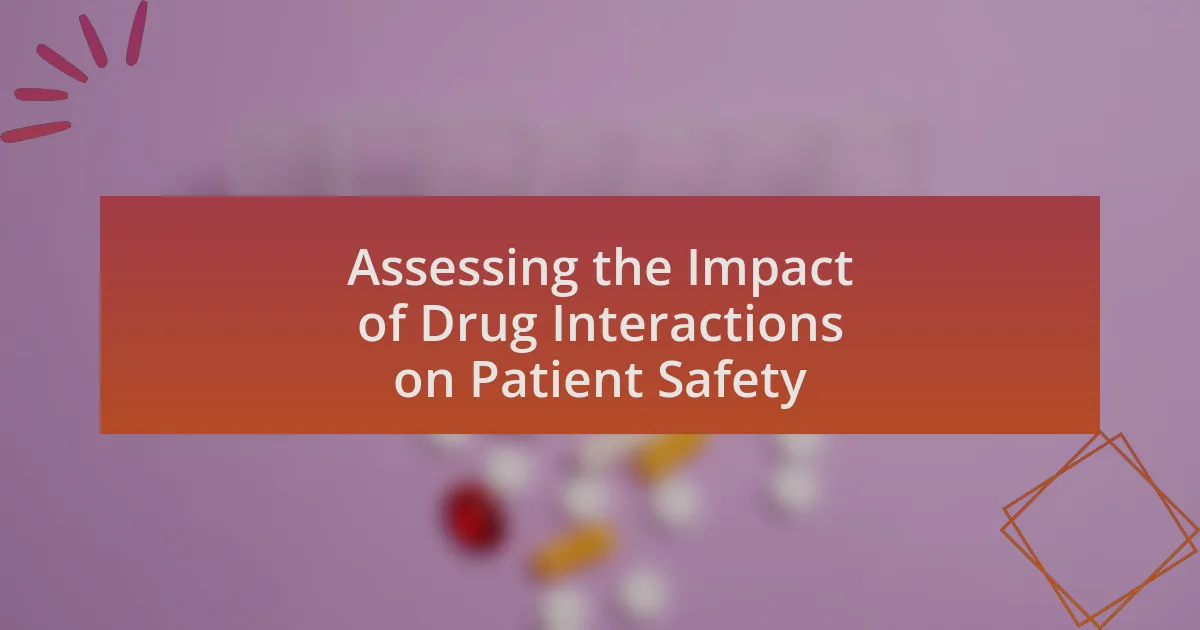The article provides comprehensive guidelines for the safe disposal of unused medications, emphasizing the importance of preventing accidental ingestion, misuse, and environmental contamination. Key methods include returning medications to drug take-back programs, following specific disposal instructions on labels, and safely disposing of them in household trash when necessary. It highlights the risks associated with improper disposal, such as contamination of water supplies and increased potential for substance abuse. The article also outlines legal considerations, available resources, and best practices for individuals to ensure responsible medication disposal.
What are the Guidelines for Safe Disposal of Unused Medications?

The guidelines for safe disposal of unused medications include returning them to a drug take-back program, following specific disposal instructions on the medication label, and disposing of them in household trash if no other options are available. Drug take-back programs are often organized by local pharmacies or law enforcement agencies, providing a safe way to dispose of medications. If disposal instructions are provided, they should be followed closely to ensure safety. When disposing of medications in the trash, it is recommended to mix them with an undesirable substance, such as used coffee grounds or kitty litter, and place the mixture in a sealed container to prevent accidental ingestion. These practices help prevent environmental contamination and reduce the risk of misuse.
Why is it important to dispose of unused medications safely?
It is important to dispose of unused medications safely to prevent accidental ingestion, misuse, and environmental contamination. Improper disposal can lead to children or pets accidentally consuming medications, which can result in serious health risks or fatalities. Additionally, when medications are flushed or thrown in the trash, they can contaminate water supplies and harm aquatic life. According to the U.S. Environmental Protection Agency, pharmaceuticals in water can disrupt ecosystems and pose risks to human health. Safe disposal methods, such as take-back programs or designated disposal sites, mitigate these risks effectively.
What risks are associated with improper disposal of medications?
Improper disposal of medications poses significant risks to public health and the environment. When medications are discarded inappropriately, they can contaminate water supplies, leading to potential exposure for humans and wildlife. Studies have shown that pharmaceuticals can persist in aquatic environments, affecting aquatic life and disrupting ecosystems. Additionally, improper disposal increases the risk of accidental ingestion or misuse, particularly among children and pets, which can result in poisoning or overdose. Furthermore, the presence of unused medications in the community can contribute to substance abuse, as these drugs may be accessed by individuals seeking to misuse them.
How does safe disposal protect the environment and public health?
Safe disposal protects the environment and public health by preventing harmful substances from contaminating soil, water, and air. When medications are improperly discarded, they can leach into groundwater or be released into ecosystems, leading to toxic effects on wildlife and plants. For instance, studies have shown that pharmaceuticals found in water bodies can disrupt aquatic life, affecting reproduction and growth. Additionally, safe disposal reduces the risk of accidental ingestion or misuse of medications, which is crucial for public health; the Centers for Disease Control and Prevention reported that improper medication disposal contributes to the opioid crisis and increases the likelihood of overdoses. Therefore, adhering to safe disposal guidelines mitigates environmental contamination and safeguards community health.
What types of medications require safe disposal?
Medications that require safe disposal include prescription drugs, over-the-counter medications, and any substances that contain controlled substances. These types of medications can pose risks to human health and the environment if not disposed of properly. For instance, opioids and other controlled substances can lead to misuse or accidental ingestion, while certain over-the-counter medications may contain ingredients harmful to aquatic life if flushed. The U.S. Drug Enforcement Administration (DEA) recommends that these medications be disposed of through take-back programs or specific disposal methods to mitigate these risks.
Which prescription medications should be disposed of safely?
Prescription medications that should be disposed of safely include opioids, benzodiazepines, and certain antidepressants. These medications pose significant risks if misused or accidentally ingested, particularly by children or pets. The U.S. Drug Enforcement Administration (DEA) recommends that these medications be disposed of through authorized take-back programs or by following specific disposal instructions on the medication label, which often include flushing certain medications down the toilet to prevent potential harm.
Are over-the-counter medications also subject to safe disposal guidelines?
Yes, over-the-counter medications are subject to safe disposal guidelines. These guidelines are established to prevent environmental contamination and accidental ingestion. The U.S. Food and Drug Administration (FDA) recommends specific disposal methods for both prescription and over-the-counter medications, including flushing certain medications down the toilet and utilizing drug take-back programs. These measures help ensure that medications do not pose risks to public health or the environment when they are no longer needed.
What methods are recommended for the safe disposal of unused medications?
The recommended methods for the safe disposal of unused medications include returning them to a drug take-back program, disposing of them in household trash after mixing with an undesirable substance, and flushing certain medications down the toilet if specified. Drug take-back programs are often organized by local pharmacies or law enforcement agencies, ensuring that medications are disposed of safely and responsibly. The U.S. Food and Drug Administration (FDA) advises mixing medications with substances like coffee grounds or kitty litter before placing them in the trash to prevent accidental ingestion. Additionally, the FDA provides a list of medications that can be safely flushed, which helps to minimize the risk of misuse and environmental contamination.
How can medications be disposed of at home?
Medications can be disposed of at home by following specific guidelines to ensure safety and environmental protection. The U.S. Food and Drug Administration (FDA) recommends mixing medications with an unpalatable substance, such as dirt, cat litter, or used coffee grounds, and placing the mixture in a sealed plastic bag or container before throwing it in the household trash. Additionally, certain medications may have specific disposal instructions, and flushing them down the toilet is advised only for those that are specifically listed as safe to flush, as this helps prevent accidental ingestion and environmental contamination. Following these steps helps mitigate risks associated with unused medications.
What are the benefits of using drug take-back programs?
Drug take-back programs provide a safe and effective way to dispose of unused or expired medications, significantly reducing the risk of accidental poisoning and drug misuse. These programs help prevent medications from entering the environment, thereby protecting water sources and wildlife. According to the U.S. Drug Enforcement Administration, in 2021, over 1,000 tons of medications were collected through take-back events, demonstrating their effectiveness in promoting public health and safety. Additionally, these programs raise awareness about the importance of proper medication disposal, encouraging responsible practices among the public.
How can individuals prepare medications for safe disposal?
Individuals can prepare medications for safe disposal by following specific steps to minimize environmental impact and prevent accidental ingestion. First, they should mix the medications with an undesirable substance, such as used coffee grounds or kitty litter, to make them less appealing. Next, they should place the mixture in a sealed plastic bag or container to prevent leakage. Finally, individuals should dispose of the container in the household trash. The U.S. Food and Drug Administration (FDA) recommends this method to ensure that medications are not easily accessible to children or pets, thereby reducing the risk of accidental poisoning.
What steps should be taken to secure medications before disposal?
To secure medications before disposal, first, gather all unused or expired medications and store them in a locked cabinet or container to prevent unauthorized access. This step is crucial as it minimizes the risk of accidental ingestion or misuse, particularly by children or pets. Next, remove personal information from medication containers to protect your privacy. Finally, follow local guidelines for disposal, which may include returning medications to a pharmacy or participating in a take-back program, ensuring that medications are disposed of safely and responsibly. These actions collectively help to prevent environmental contamination and safeguard public health.
How should medications be packaged for safe disposal?
Medications should be packaged for safe disposal by placing them in a sealed plastic bag or container to prevent leakage and contamination. This method ensures that the medications are securely contained, reducing the risk of accidental ingestion by children or pets. Additionally, it is recommended to mix the medications with an undesirable substance, such as used coffee grounds or kitty litter, before sealing them in the bag or container. This practice further deters misuse and makes the medications less appealing. Following these steps aligns with guidelines from the U.S. Food and Drug Administration, which emphasizes the importance of safe disposal methods to protect public health and the environment.
What are the legal considerations regarding medication disposal?
Legal considerations regarding medication disposal include compliance with federal, state, and local regulations that govern the proper disposal of pharmaceuticals. The Drug Enforcement Administration (DEA) mandates that controlled substances must be disposed of through authorized collection sites or methods, such as take-back programs, to prevent environmental contamination and misuse. Additionally, the Resource Conservation and Recovery Act (RCRA) outlines hazardous waste management, requiring certain medications to be treated as hazardous waste if they meet specific criteria. Failure to adhere to these regulations can result in legal penalties, including fines and criminal charges.
What regulations govern the disposal of controlled substances?
The disposal of controlled substances is governed primarily by the Drug Enforcement Administration (DEA) regulations, specifically under the Controlled Substances Act. These regulations mandate that controlled substances must be disposed of in a manner that prevents diversion and misuse, often requiring the use of authorized collection sites or methods. For instance, the DEA’s regulations allow for the disposal of controlled substances through take-back events, mail-back programs, and disposal at authorized facilities, ensuring compliance with federal law.
How can individuals ensure compliance with local disposal laws?
Individuals can ensure compliance with local disposal laws by researching and following the specific regulations set by their local government or waste management authority regarding medication disposal. This can be achieved by visiting official websites, contacting local health departments, or consulting pharmacists for guidance on proper disposal methods. Many areas provide designated collection sites or events for safe medication disposal, which are established to prevent environmental contamination and misuse. Following these guidelines helps individuals adhere to legal requirements and promotes public health and safety.
What resources are available for safe medication disposal?
Safe medication disposal resources include local take-back programs, drug disposal kiosks, and guidelines from the U.S. Food and Drug Administration (FDA). Local take-back programs, often organized by pharmacies or community organizations, provide designated days or locations for safe medication return. Drug disposal kiosks, typically found in pharmacies or law enforcement agencies, allow individuals to drop off unused medications securely. The FDA offers specific guidelines on disposing of medications, recommending flushing certain drugs down the toilet if they pose a risk to others, while others can be thrown in the household trash after mixing with undesirable substances. These resources ensure that medications are disposed of safely, minimizing environmental impact and preventing misuse.
Where can individuals find local drug take-back events?
Individuals can find local drug take-back events through the Drug Enforcement Administration (DEA) website, which provides a searchable database of events by state and date. Additionally, local pharmacies, hospitals, and community organizations often host or promote these events, making them accessible to the public. The DEA’s National Prescription Drug Take Back Day, held biannually, is a significant initiative that encourages safe disposal of unused medications, and details about these events are widely advertised through various channels, including social media and local news outlets.
What online resources provide information on medication disposal?
The online resources that provide information on medication disposal include the U.S. Food and Drug Administration (FDA) website, which offers guidelines on safe disposal methods, and the Drug Enforcement Administration (DEA) website, which provides information on drug take-back programs. Additionally, the National Institute on Drug Abuse (NIDA) offers resources related to the safe disposal of medications. These platforms are reliable sources for understanding the best practices for disposing of unused medications safely and responsibly.
What best practices should be followed for safe disposal of unused medications?
The best practices for safe disposal of unused medications include returning them to a drug take-back program, following specific disposal instructions on the medication label, and utilizing household trash disposal methods when necessary. Drug take-back programs are often organized by local pharmacies or law enforcement agencies, providing a secure way to dispose of medications and preventing environmental contamination. If no take-back options are available, medications can be mixed with an unpalatable substance like dirt or cat litter, placed in a sealed container, and thrown away in the household trash. Additionally, flushing certain medications down the toilet is recommended only if specified on the label, as this helps prevent accidental ingestion and misuse. These practices are endorsed by the U.S. Food and Drug Administration, which emphasizes the importance of proper disposal to protect public health and the environment.
How can individuals educate themselves and others about safe disposal?
Individuals can educate themselves and others about safe disposal by accessing reliable resources such as the U.S. Food and Drug Administration (FDA) guidelines, which provide specific instructions on how to dispose of unused medications safely. Engaging in community programs, such as local drug take-back events, allows individuals to learn and share best practices for medication disposal. Additionally, discussing safe disposal methods with healthcare providers can enhance understanding and dissemination of accurate information. According to the FDA, improper disposal of medications can lead to environmental contamination and accidental ingestion, highlighting the importance of education in promoting safe practices.
What common mistakes should be avoided when disposing of medications?
Common mistakes to avoid when disposing of medications include flushing them down the toilet, which can contaminate water supplies, and throwing them in the trash without proper preparation, which can lead to accidental ingestion by children or pets. Additionally, not utilizing drug take-back programs, which are designed to safely collect unused medications, is a significant oversight. The U.S. Drug Enforcement Administration (DEA) recommends these programs as a safe disposal method to prevent misuse and environmental harm.





